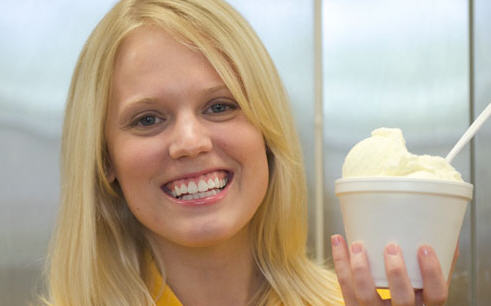It's too late for this summer, but some time soon you could be enjoying an experimental ice cream that starts as one flavor then shifts to another before being swallowed.
It's not vanilla and chocolate mixed, it's vanilla transformed.
Elizabeth Fenner, a food science graduate student at the University of Missouri College of Agriculture, Food and Natural Resources, says the goal is not to mix two flavors into a third flavor, but to have two distinct sensations of taste separated by a second or two.
Her process uses micro-encapsulation techniques that coat the second flavor but the substance breaks down almost immediately in the mouth, releasing additional flavor compounds. She says the project isn‘t intended to create a commercial project but, come on, why wouldn't Ben&Jerry's rather have a Ben And Then Jerry's?

Elizabeth Fenner. Credit: CAFNR
Micro-encapsulation of food is a relatively new process, less than two decades old, and it involves covering flavor compounds in a wax, gelatin, protein or food-grade polymer casing just millionths of a millimeter in size. It's most common in chewing gum but also used to coat probiotic bacteria for protection from gastric activity or to delay premature flavor release in food during microwaving. Many long-acting pharmaceuticals use this technology also.
What's her secret? Polymers? Vegetable oils? Clarified butter? Fenner isn't telling.
Fenner conducted taste tests of the final and unnamed version with student volunteers in MU’s food sensory laboratory. On the Nine-Point Hedonic Scale, where nine is considered outstanding, raters gave the new ice cream sevens and eights.
Testers immediately got the idea that this was a fun novelty product and said they would consider buying it. They consumed all of their samples and sometimes wanted more, a good sign the ice cream had been enjoyed. So far, only cherry has been tested as a second flavor. The more complex flavors of chocolate would open whole new research challenges.
Micro-encapsulation of ice cream has other benefits, too, Fenner found. Volatile flavor compounds in conventional ice cream break down after about six months of storage, leaving the ice cream somewhat tasteless. Food coloring also darkens in time. Encapsulated compounds can last almost twice as long in original taste, texture and color.






Comments